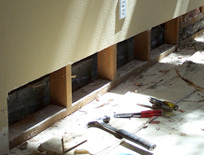Planning for a Rainy Day

 In most backyard swimming pool projects, we install the drainage systems for decks after the swimming pool’s plumbing, basically because the pool plumbers use big trenchers that will likely destroy the small drainage plumbing if it’s already in place.
In most backyard swimming pool projects, we install the drainage systems for decks after the swimming pool’s plumbing, basically because the pool plumbers use big trenchers that will likely destroy the small drainage plumbing if it’s already in place.
That sequencing, combined in one instance with bad timing and a minor lapse in common sense, led to an enormous problem in one of our recent projects. It happened in a side yard where the plumber had just dug trenches for the pool’s lines but we had yet to address issues of sheet-flow and rainwater drainage.
Scenario: As bad luck would have it, the evening after those big trenches were dug, the skies opened up with unusually torrential rainfall. Not only was the side yard completely unprepared for rain, but also the trenches and the spoils dramatically aggravated the problem because the trenches were oriented in such a way that they blocked the water’s exit from the yard.
Hindsight is 20/20, but basically, when you dig a trench and then pile up the spoils beside it for later removal, you might inadvertently be creating an absolutely perfect structure for making sure water stays right where it is. In our case, the trenches collected the water, caused it to stop flowing and enabled it to saturate the ground as well as the linear pile of dirt, making it act like a dam.
The impromptu pond that formed in the middle of the night was bounded on one side by an exterior living room wall. Topping it all off, the living room was recessed inside the house: It’s floor sat right on grade, forming the lowest point in the house.
Early the next morning, we received a call from the client letting us know that there was an inch of water in the living room. It had flowed up through the weep screed, over the foundation and into the walls, ruining the carpet and damaging some very nice, very expensive furniture.
This is, of course, the kind of thing that will upset even the most temperate of clients — and will set emotional ones into states of pure panic. In this case, the clients were cool people who let us work out the problem in ways that involved minimal hassle.
We acted quickly, ripping out the carpet and carting it away. We then dried the floor and cut away the bottom two feet of drywall the length of the room to let it dry out. After spraying the wood structure with bleach to prevent mold and bringing in a mold-remediation specialist to test our work, we let everything dry before reinstalling the drywall, painting the room and replacing the carpet. Happily, the furniture was fine once we dried and cleaned it.
Frankly, we got off easy on this one, thanks mainly to quick action and our good relationship with the client. In other situations, I could imagine the remediation costing several times what it did in this situation.
Later on, I had an animated conversation with the plumber about what had happened. He refused to take any responsibility for what took place, but to this day I’m convinced he was to blame.
The Fix: Preventing this problem is as easy as being aware that trenching can cause flooding when it rains, and that you need to be sure to give water a place to go whenever and wherever it might accumulate. For the most part, all it takes is cutting a small channel or deploying sandbags that will allow the water to keep flowing away from the disturbed area.
In this case, we cut a line perpendicular to the house that trapped the water. We should have known better and definitely should have cut a short trench parallel to the wall of the house that would’ve allowed the water to flow away from the building. It’s as simple as that: A few minutes’ labor would have saved us thousands of dollars.
Most contractors live and die by the weather and are always thinking about protecting dry materials or a fresh excavation or newly poured concrete when storm clouds gather. Given the fact that this rainy-day thinking is part of what we all do anyway, I’d say thinking through such drainage issues is just another item to add to our internal punch lists.
Lesson Learned
Although this applies to just about everything we’re covering in this series of “Lessons Learned,” preventing flooding boils down to learning from your mistakes (or, better yet, from the mistakes of others), communicating with staff and subcontractors, and taking the necessary steps to make sure bad things don’t happen. Literally, it all breaks down to planning for a rainy day!
Scott Cohen is president and supervising designer of The Green Scene, an outdoor design and construction firm based in Canoga Park, Calif. He provides consultation for clients nationwide and gives seminars on designing landscapes, swimming pools and outdoor kitchens. For more information, visit www.greenscenelandscape.com.









